LearnedAmateur
National Hazard
   
Posts: 513
Registered: 30-3-2017
Location: Somewhere in the UK
Member Is Offline
Mood: Free Radical
|
|
Unexpected manganese compound
Back again with another manganese-related salt post.
So I had managed to prepare some relatively pure MnCl2 with another method involving only manganese dioxide and hydrochloric acid. It formed the
expected red-pink solution due to the presence of Mn2+ (sample image 1). Upon heating, the colour changed from this to green, and eventually yellow
(image 2). Boiling the solution down, a tan precipitate formed which dropped out as a powder (image 3), which redissolved upon the addition of more
water to reform the yellow solution. The solution subsequently produced yellow crystals of irregular morphology (images 4 and 5).
I've briefly trawled the internet and cannot find any reference to yellow manganese compounds. I can safely rule out the presence of chlorine because
the crystals are also yellow, under the assumption that Cl2 would remain in the aqueous phase. There is a slight sweet smell not unlike that of
aldehydes, but it is barely detectable and likely not too relevant. Any ideas on what compound I have formed?
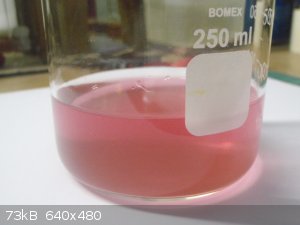 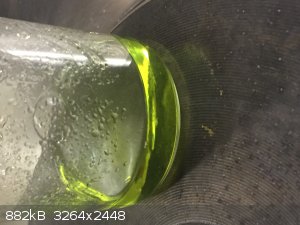 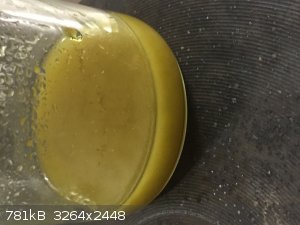 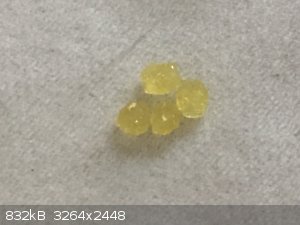 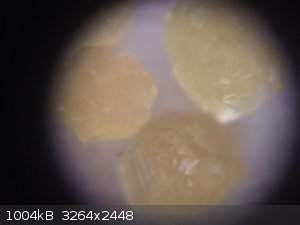
|
|
|
MrHomeScientist
International Hazard
    
Posts: 1806
Registered: 24-10-2010
Location: Flerovium
Member Is Offline
Mood: No Mood
|
|
What is your source of hydrochloric acid? Hardware store grade acid is frequently contaminated with iron, which when concentrated after boiling might
explain the greens and yellows.
|
|
|
LearnedAmateur
National Hazard
   
Posts: 513
Registered: 30-3-2017
Location: Somewhere in the UK
Member Is Offline
Mood: Free Radical
|
|
Synthesised from the reaction between sulphuric acid and sodium chloride, bubbled into water at unknown concentration, but there's definitely a
significant amount present.
I'll prepare a precipitate using hydroxide and carbonate, see what it forms; the first tube shows brown precipitate darkening on top, indicative of
manganese hydroxide. The second contains the light tan precipitate of manganese carbonate.
[Edited on 8-5-2017 by LearnedAmateur]
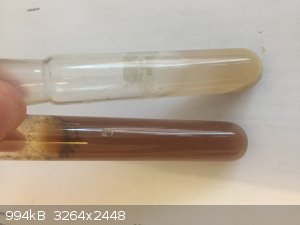
|
|
|
MrHomeScientist
International Hazard
    
Posts: 1806
Registered: 24-10-2010
Location: Flerovium
Member Is Offline
Mood: No Mood
|
|
Quote: Originally posted by LearnedAmateur  | | Synthesised from the reaction between sulphuric acid and sodium chloride, bubbled into water at unknown concentration, but there's definitely a
significant amount present. |
Distilled water? Or tap water? Trying to pin down sources of contaminants.
Quote: Originally posted by LearnedAmateur  |
I'll prepare a precipitate using hydroxide and carbonate, see what it forms; the first tube shows brown precipitate darkening on top, indicative of
manganese hydroxide. The second contains the light tan precipitate of manganese carbonate.
[Edited on 8-5-2017 by LearnedAmateur] |
Wiki lists Mn(OH)<sub>2</sub> as being white and quickly darkening upon exposure to air. The darkening you see definitely sounds good for
manganese, but what about the rest of the solids? Did the precipitate immediately come out brown, or did it darken over time? Instant brown would
suggest iron to me. I suppose it's possible it could be from dissolved oxygen in your solutions, in which case you could boil both solutions to de-gas
them before mixing together and see if that comes out with anything different.
Of course if you have any ferricyanide, ferrocyanide, or thiocyanate, that's a more definitive test for iron and would give you a better answer.
Here's a neat document about testing for iron in food samples with thiocyanate.
Attachment: Determination of Iron by Thiocyanate Colorimetry.pdf (168kB)
This file has been downloaded 296 times
|
|
|
elementcollector1
International Hazard
    
Posts: 2684
Registered: 28-12-2011
Location: The Known Universe
Member Is Offline
Mood: Molten
|
|
I've encountered this or a similar green stuff as well, though in a different form. I don't think I have the pictures left, but maybe they can be
found in the manganese chloride thread.
Anyway, I was boiling down bubblegum-pink MnCl2 solution a few years back. Everything was going fairly well, and I had no evidence before
this to indicate at any time that there were impurities in the manganese, especially iron. The solid precipitates out, and I boil to dryness to remove
as much water as possible (having been annoyed earlier by hygroscopicity and not having much in the way of secure storage containers).
Now, here's the part where the green stuff comes in. As soon as the last bit of the solution disappeared, the whole stock of bright pink, solid
manganese chloride turned lime green. Almost instantaneously. I didn't even catch it until my dad pointed it out to me and I turned around again, and
by that time it had begun shifting back to pink again.
I used an OTC source of hydrochloric acid - TransChem brand, if I remember right, and manganese dioxide from batteries that I had purified following
NurdRage's video. Now, I know everyone says the OTC hydrochloric acid is contaminated by iron because it's green, but has anyone ever managed to prove
it? Nobody I know has managed to get the iron back out of there, and you'd think it would be quite easily done with some NaOH.
That was the only time I ever saw manganese chloride turn green, as it stayed pink upon cooling and at all times thereafter. I kind of forgot about it
until now, honestly.
Those precipitates of manganese hydroxide and carbonate look exactly like the ones I worked with, so I'm pretty sure they're of reasonable purity.
MrHomeScientist, air and heat do most of the work in changing the color of manganese hydroxides, from white Mn(OH)2 to hydrated brown
MnO2. I've noticed that hot NaOH will solely form brown manganese dioxide, while cold, dilute NaOH will form the lighter, off-white
hydroxide, which turns brown on exposure to air as it converts to the hydrated dioxide.
What could the green stuff be? I know different hydrates of salts can have completely different colors, cobalt's a good example of that. But if
manganese chloride has a different hydrate that's yellow to green in color, how come nobody's noticed?
EDIT: Found the pictures I was referencing. Forgot I was actually quick enough to get a photo in, so you can see the green I'm talking about on the
first one. The second is just seconds to minutes later.
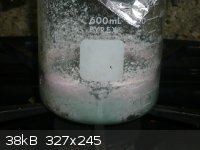
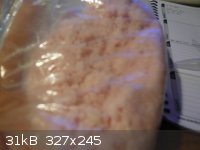
[Edited on 5/8/2017 by elementcollector1]
Elements Collected:52/87
Latest Acquired: Cl
Next in Line: Nd
|
|
|
JJay
International Hazard
    
Posts: 3440
Registered: 15-10-2015
Member Is Offline
|
|
Some OTC hydrochloric acid leaves a green residue. I have seen it before but actually haven't run into any that does that in several years... does
your hydrochloric acid leave a residue when evaporated?
|
|
|
LearnedAmateur
National Hazard
   
Posts: 513
Registered: 30-3-2017
Location: Somewhere in the UK
Member Is Offline
Mood: Free Radical
|
|
@MrHomeScientist
It was bottled water, the analysis on the label doesn't show iron concentration and the lowest is potassium, at 1mg/L - the other metal ions are: Ca
80mg/L, Mg 26, Na 6.5. It was immediately dark with the OH solution, if it is iron then I can't see how it could've been introduced unless it was
through the MnO2. Here's an image of iron hydroxide (left), with my sample of hydroxide. Albeit, even this doesn't explain why my solution changed
colour so drastically from the original, I would've expected it to stay pink since I didn't alter the initial Fe2+/3+ concentration.
@elementcollector1
That's interesting, for me it occurred during the boiling phase when everything was still in solution. Almost immediately as it started to give off
visible steam, it went the lime green then yellow, then it precipitated, never returning to the pink colour. I used hot (from the enthaply of
solution), concentrated NaOH, so that would explain the dark colour as per your comment.
@JJay
I used all of the hydrochloric acid I synthesised, it was only a small amount of ~40mL, but I'll make some more using the same method and reagents as
before when I get the chance.
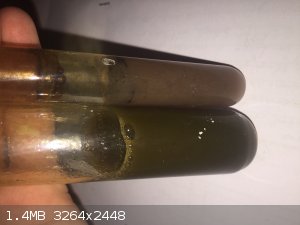
[Edited on 8-5-2017 by LearnedAmateur]
|
|
|
Texium
Administrator
       
Posts: 4508
Registered: 11-1-2014
Location: Salt Lake City
Member Is Offline
Mood: PhD candidate!
|
|
Where did you get your manganese dioxide and what grade is it? I'm surprised nobody has asked that yet, as that seems like something important to
address.
|
|
|
Texium
|
Thread Moved
8-5-2017 at 14:18 |
LearnedAmateur
National Hazard
   
Posts: 513
Registered: 30-3-2017
Location: Somewhere in the UK
Member Is Offline
Mood: Free Radical
|
|
Decomposition of potassium permanganate, I hung onto it after an oxidation reaction. It was washed with dilute sulphuric acid, filtered with a
Büchner funnel washed again with water, then dried under pressure.
|
|
|